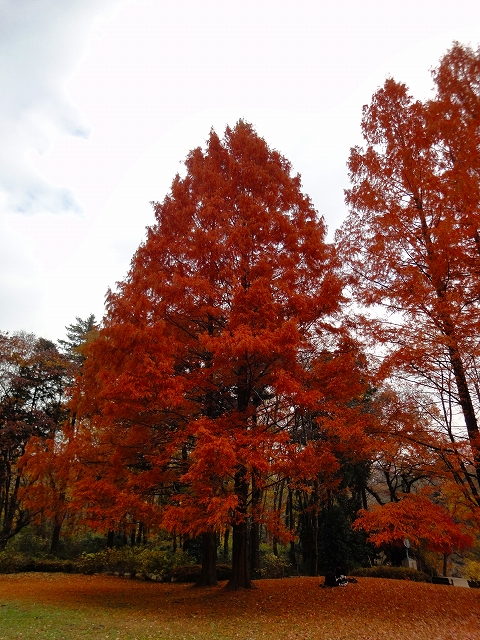 |
| Incredible Looking Flowers ????? |
I spent much time wandering around looking at other flower beds at the Göteborg Botanical Gardens and came across these very interesting looking small flowering plants on a steep slope, yet there was no signage describing to me what I was seeing. The combination of yellows and blueish-purples. Maybe somebody viewing this knows exactly what the plant is. Yet on close up inspection of the plant, not everything was what it seemed. It actually reminded me of Poinsetta plants where what most people consider a flower is actually the leaves, The actual flowers being yellow and very tiny compared to the giant red leaves. Take a closer view below.
 |
| See what I mean ?????????? |
But there were further things that caught my interest. Mostly I've never been to an area with so many wild varieties of BumbleBees. In most places on the Earth today they have become either extinct or mostly absent from the urban scenes. Honey Bees have replaced them, but even they are up a creek so to speak with the Colony Collapse Disorder (CCD) in recent News on a global scale. But here around Göteborg, Sweden they are able to thrive.
 |
| Bumble Bee on a variety of Salvia |
 |
| Honey Bee on Purple Cone Flower (Echinacea purpurea) |
 |
| Photo: Mine |
There were some Butterflies but not many. We always called these in our gardens back home Cabbage Moths and there was a yellow variety there. But who knows, I'm not exactly an expert on bug world names except many of the familiar common ones I am use to back home. But then I found one below that was far more interesting.
 |
| Photo: Mine |
Does not look all that spectacular, but wait till it opens his/her wings. I must have waited close to an hour.
 |
| Photo: Mine |
It was worth the wait and yet the shot was difficult. Let's face it, I'm in someone else's extremely manicured backyard where the gardens are perfectly neat and in order to get some better close-ups you've got to stick your big feet into the fluffy tilled amended soil or onto some other plants and that wouldn't have gone down real well as there were many of visitors watching every move you made. Okay, I only made a couple of giant size 12" footprints, But I brushed them a bit afterwards. *smile*
 |
| Photo: Mine |
There were a couple of interesting critters in the bee/fly family like this guy who had the ability to perform a number of precision helicopter antics and stunts. Interesting also is that all of these guys had their favourite flowers that appealed to them specifically. This little Chihuahua dude above only liked this plant and it's petite raspberry coloured flowers
 |
| Photo: Mine |
This was just a kool shot of another variety of Echinacea with long drooping pink flower petals with the reflection pool in the background.
 |
| Photo: Mine |
Going back to my original entry which I wrote about in the beginning of this series where the Gardeners had incorporated various Cacti & Agave into desert flower mixes, I found that I had missed a few details. Here was some of the native New Mexico flowers I mentioned from a previous article which was the Mexican Hat Coneflower (Ratibida columnifera)
 |
| Photo: Mine |
And how could you not incorporate these into the mix of all things Desert decor. Chile pepper plants of all sorts are sold here everywhere as ornamental indoor-outdoor decor plants. I doubt the Swedes here use them much for culinary arts as they tend to burn their northern European lips on Katsup.
 |
| These really reminded me of California Tiger Lily |
 |
| Another Bumble Bee shot |
 |
| Photo: Mine |
This little guy was all by him/herself. Generally I usually see these guys in large numbers, even in the States. Can't remember the name, but Margarethe Brummermann of Tucson Arizona would surely know.
 |
| Just another shot of the flower with Bumble Bee |
 |
| Another succulent directional sign |
 |
| Magnollia stellata 'Centennial' |
Finally before I exited the gardens I had to go back and take some photos of the desert themes in between some of the rocks with plants that appeared desert-like, but weren't. I just caught a couple more angles of some of these amazing settings that look like they shouldn't belong here in Sweden.
 |
| Magnollia stellata 'Centennial' | | | |
 |
| Magnolia sieboldii 'Buskmagnolia' |
Now below here is another variety of Magnolia they
incorporated into the rocks which is actually behind the photograph
just above here. Take a look at it's shape and form and once again use the imagination on how such a plant could be incorporated into a landscape that doesn't necessarily allow for a true Desert theme. Notice also the understory planting ? I'll place that picture below this one.
 |
| Magnolia sieboldii 'Buskmagnolia' | | |
|
 |
Marmalade Coral Bells
Heuchera x 'Marmalade'
|
Just after I made the final exit and before I actually rode the trolley home, I visited a spot where I had been a few times at the end of the Trolley #10 line where an interesting 'U' shaped Apartment complex design reminded me of something else in nature that can have a natural shaping and growth guiding effect on trees like this Black Locust (Robinia pseudoacacia) which incredibly does very well over here.
 |
| Spring Blooms |
We have a stand of them grown in a long row along a boulevard where we live, but they are in the open and more rounded in appearance. This one below is long tall and slender. Something also that I would imagine seeing in a slot canyon in Northern Arizona in Redrock country. Look at the way the building's walls perfectly shape it. One of the other major rewards for those in climates not conducive to growing citrus is the 'Orange Blossom' fragrance which permeates the air all around your garden when these flowers display the white Wysteria like blossom clusters.
 |
| Black Locust (Robinia pseudoacacia) |
 |
| Photo: Mine |
Again I love the tall slender growth which allows for numerous other plants under the tree in a courtyard setting. The two trees on either side are Norway Maples.
 |
| Just another angle from within the courtyard itself. |
 |
| Looking up from the base of the tree at it's trunk |
 |
| Photo: Mine |
And one last shot before leaving for home. This tree is an amazing survivor. Not only does it accept this cold freezing often wet rainy (Sucky) climate, but it does well in Southern California in hot dry interior valleys and high deserts. Truly remarkable and something to consider with the in between climates. Not sure about low deserts, but maybe someone else can comment on examples they may know of.
For more on Robinia, see my piece on New Mexico Locust at my "Earth's Internet" blog where I explain the networking abilities underground with this plant's relationship networking to other plants within it's ecosystem community.
Tomorrow one last look at a specimen tree that has nothing to do with the Desert theme, but a tree once thought extinct and only found in the fossil records until someone discovered it was in China in 1945.























































